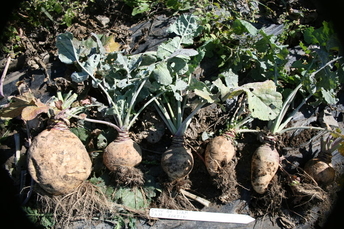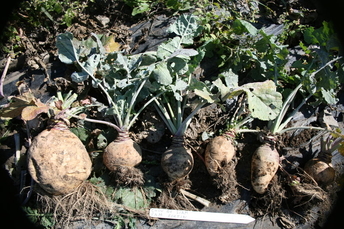 Whenever you plan to grow out a plant variety for seed, you should think about the number of plants you should grow to get a good result. That means more than just harvesting enough seeds; it means properly preserving the genetics of the variety by saving seeds from several plants.
Whenever you plan to grow out a plant variety for seed, you should think about the number of plants you should grow to get a good result. That means more than just harvesting enough seeds; it means properly preserving the genetics of the variety by saving seeds from several plants.
We often tend to think that plants are alike if they look alike, but actually they can be quite different in ways we just don't notice. Think about a row of lettuce for instance. If the leaves on all the plants are the same shape and colour, and if the heads are all about the same shape and size, and if they all taste the same, then you'd think all those lettuce plants are genetically alike. You'd think you could just take seeds from one plant, and you'd preserve all the characteristics of that variety.
Unfortunately, no.
Those plants are all the same variety because someone selected them all to have the same shape, colour, and taste. In other words, sometime in the past, a seed grower looked through their row of that lettuce and removed all the plants that had different shapes, colours, and taste, just leaving the uniform-looking plants to go to seed. That's why they all look and taste uniform now. However, they didn't necessarily select out any plants based on any other characteristics, like drought tolerance, disease resistance, seed longevity, root vigour, etc. That means some of your "uniform" plants are more drought tolerant than others, some have better root systems than others, and some make longer-lasting seeds than others.
Sometimes you can see those traits, but sometimes you can't. For instance during a drought, you can see which plants grow better. But if it has rained recently, the drought-tolerant plants look just like the rest. Disease resistance is great, but you can't tell which plants are resistant unless the others are diseased. You can assess the plant above-ground easily enough, but you can't see which plants have the most extensive root systems unless you dig down with a very tiny shovel and see for yourself. These "invisible" traits are extremely important, but they hide most of the time.
Suddenly, your lettuce row doesn't seem so uniform after all. If you take seeds from only one plant, how do you know whether you're collecting good root genetics, good seed storage genetics, and good disease-resistance genetics? Maybe you'll choose a plant that has none of those things, and forever afterward all your lettuce will be weaker and poorer quality.
When you save seeds from many plants at once, that's your insurance policy for keeping the best genes, even if you can't see their effects. Sure, you'll collect the weaker of the hidden genes too, but at least you avoid the peril of losing the strong ones. In the future, the stronger genes will survive and dominate, so they're worth keeping at any cost.
So how many plants do you have to save seeds from to capture the full hidden genetics of a variety? You can think of it like this: say you have a bag of coloured marbles and you want to take a random handful that contains at least one of every colour. How big a handful will make you pretty sure (say 19 times out of 20) that you'll get at least one marble of every colour? The answer depends on how many colours there are. In population genetics, the same concept is used, and some tricky math, to determine a minimum population size. That is, the minimum number of plants you should harvest seeds from, to be pretty sure that you'll collect the full genetics of a variety.
Typical minimum population sizes recommended for commercial seed production:
- Bush beans : 40 plants
- Cucumber : 20 plants
- Lettuce : 20 plants
- Pepper (sweet) : 20 plants
- Tomato : 20 plants
These are the minimum number of plants that a commercial seed grower should save seeds from, to be 95% confident of preserving the complete genetics of each variety. Commercial growers often grow more than that, but these numbers might seem like a lot for a home seed saver.
The community standards for personal seed-saving look more reasonable for the home garden scale:
- Bush beans : 20 plants
- Cucumber : 6 plants
- Lettuce : 6 plants
- Pepper (sweet) : 6 plants
- Tomato : 6 plants
The difference is that the community standard will give you good results most of the time, but there is no guarantee that rare traits will be preserved from generation to generation, and the variety has a chance of becoming weaker over time.

